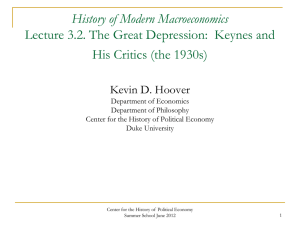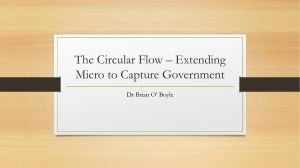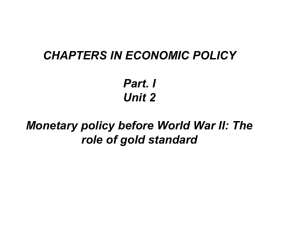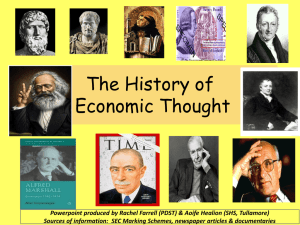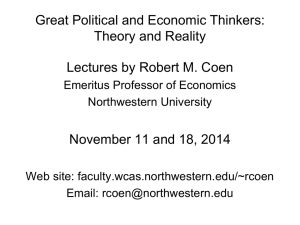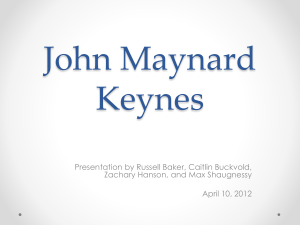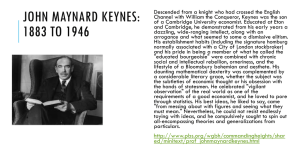Unit3
advertisement
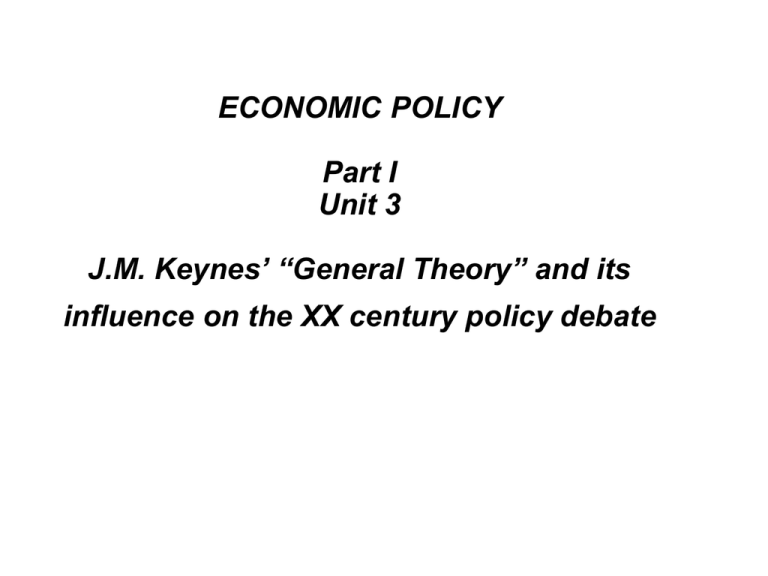
ECONOMIC POLICY Part I Unit 3 J.M. Keynes’ “General Theory” and its influence on the XX century policy debate • Classical and neo-classical (pre-keynesian) economists maintained that market mechanisms, provided that free competition held, were able to ensure an optimal allocation of resources and full employment • In the Walras-Pareto general equilibrium models, prices adjust very rapidly (actually instantaneously). Both the markets for productive services and for consumer commodities are in equilibrium L. Walras (1834-1910): governments should avoid to intervene in the economic system. The only role of government is to guarantee the legal framework for free competition. In particular, it should: i) guarantee the enforcement of contracts and the security of private property ii) dismantle monopolies (natural monopolies should be nationalized) Discretionary monetary and fiscal policies are not even contemplated More generally, in the neoclassical (pre-keynesian) models full employment was taken for granted According to the “Say’s Law”, supply created its own demand Household’s income was either spent ( C ) or saved ( S ) • Y=C+S Furthermore, whatever was saved by households, was invested in productive projects: • S=I Excess supply or insufficient demand were ruled out by definition. In the classical/neoclassical world nothing is hoarded or lies idle During the 1930s, however, the classical/neoclassical model appeared unable to explain the Great Depression, characterized by an unprecedented worldwide downturn of economic activity and prices and by high and persistent unemployment Keynes’ General Theory of Employment, Interest and Money (1936): a remarkable, albeit controversial, effort to explain and counteract this unprecedented economic recession In Keynes’ words: “The composition of this book has been for the author a long struggle of escape […] from habitual modes of thought and expression […] The difficulty lies not in the new ideas, but in escaping from the old ones, which ramify into every corner of our mind” (K., 1936, p. viii) The General Theory includes two parts: Part I (chapters 1-18) is a fixed price model. By adopting a partial equilibrium approach, Keynes analyses in sequence the following markets: • the labour market (chapter 2) • the goods market (chapters 3-10) • the capital market (chapters 11-12 • the money market (chapters 13-17) Part II (chapters 19-21): Keynes generalizes the previous model by assuming flexibility of wages and prices • The labour market Keynes summarizes the classical theory of employment which was based on two postulates: • • the real wage is equal to the marginal productivity of labour; the utility of wage is equal to the marginal disutility of labour Let’s draw a Cartesian coordinate plane (vertical axis W/P and horizontal axis N). Assuming that: i) the marginal productivity of labour is decreasing; ii) the marginal disutility of labour is increasing, the Classical economists were able to draw Nd (labour demand) and Ns (labour supply) as, respectively, a downward sloping and an upward sloping curve Equilibrium real wage and employment were uniquely defined by the interaction of Nd and Ns In the Classical analysis unemployment was basically “voluntary”. This was due “to the refusal or inability of a unit of labour, as a result of legislation or social practice or of […] collective bargaining or of slow response to change or of mere human obstinacy, to accept a reward corresponding to the value of the product attributable to its marginal productivity” (K., 1936, p. 6) The Classical model was also compatible with “frictional” unemployment. It did not include, on the contrary, “unvolontary” unemployment. In his analysis Keynes maintained that only the first postulate was correct: the supply of labour, on the contrary, was indeterminate: Reasons: i) Labour contracts are stipulated for money wages (W) rather than for real wage (W/P) ii) If W production costs P : “there may exist no expedient by which labour as a whole can reduce its real wage to a given figure by making revised money bargains with the entrepreneurs” (Keynes, 1936, p. 13) As a consequence, in Keynes’ view the labour market was indeterminate: the level of employment was a function of the aggregate demand The goods market and the capital market • As mentioned before, in the classical and neoclassical models aggregate supply creates by definition its own demand: the goods market is always in equilibrium (“Say’s law”) Keynes maintained on the contrary that aggregate demand could be insufficient and that this was indeed case during the Great Depression In the General Theory he analyzed separately i) consumption; ii) investment i) Consumption: is a function of the disposable income and in the aggregate is fairly stable ii) Investment: according to Keynes (and to I. Fisher), an investment decision (e.g. buying a machine) depends on the present value of the flow of profits a firm can expect from that particular investment, compared with its cost Investment depends therefore on the current interest rates, and on the expectations of the future Crucial point: according to Keynes the “basis of knowledge on which estimates of perspective yields have to be made” are extreme precarious: “we have to admit that our basis of knowledge for estimating the yield ten years hence of a railway, a copper mine, a textile factory, an Atlantic liner […] amounts to little and sometimes to nothing” (K., 1936, pp. 149-50) The role of the “animal spirits”: “In former times […] investment depended on a sufficient supply of individuals of […] constructive impulses who embarked on business as a way of life, not really relying on a precise calculation of perspective profit. The affair was partly a lottery, though with the ultimate result largely governed by whether the abilities and character of the managers were above or below the average” “If human nature felt no temptation to take a chance, no satisfaction (profit apart) in constructing a factory, a railway, a mine or a farm, there might not be much investment merely as a result of cold calculation” (K., 1936, p. 150) The unfortunate consequence, however, was that: “economic prosperity is excessively dependent on a political and social atmosphere which is congenial to the average business man” Therefore, the fear of a Labour government, or of a New Deal can cause a collapse of investment simply because upsets “the belicate balance of spontaneous optimism” On the whole, Keynes (during the 1930s) was not optimistic on the future of “capitalism” This pessimistic view was shared also by other economists: e.g.: J.A. Schumpeter, Capitalism, Socialism ans Democracy, 1942 predicted that after the war the market economies would have been replaced by a “State socialism” Anyway, if businessmen were reluctant to invest, government had to take the lead by adopting deficit spending policies aimed at improving the country’s basic infrastructures Unfortunately, this was rarely the case: indeed, Keynes observed, “wars have been the only form of large-scale loan expenditure which statesmen have thought justifiable” (K., 1936, p. 130) In Keynes’ view, any initiative aimed at employing idle factors of productions is positive, even that of “digging holes in the ground” Limits of Keynes’ analysis: he adopts a short-run perspective in which investment is as a key part of demand Keynes does not mention the role of investment in the medium-long run The money market In the classical model, the only role of money was that of medium of exchange The demand for money was therefore the following: • Md = kPY 0k1 Keynes focused his analysis on the role of money as a store of value: money indeed was by definition the asset characterized by the highest degree of liquidity The demand for money in terms of liquidity preference During a depression people have an obvious incentive to postpone investment and consumption decisions and to scramble for liquidity. This tendency, however, has the very unfortunate consequence of worsening the downturn of economic activity “Unemployment develops, that is to say, because people want the moon: men cannot be employed when the object of desire (i.e. money) is something which cannot be produced and demand for which cannot be readily chocked off” In Keynes’ view the rate of interest is “the reward for parting with liquidity for a specific period” (K., 1936, p. 167) The demand for money is a function of both income (direct relation) and the interest rate (inverse relation) The money supply is exogenous (the amount of liquidity is determined by the Central bank) In Keynes view, the transmission mechanism of monetary policy is basically indirect: • provided that the demand for money is stable, an increase in money supply (Ms) would cause a reduction of the interest rate (i), an increase in investment (assuming expectations as given) and therefore an increase in aggregate demand This mechanism, however, can become ineffective as a consequence of two factors: - high interest rate elasticity of the demand for money (extreme case: the liquidity trap) - adverse expectations in the business sectors. In these circumstances monetary policy is totally ineffective: in order to get out of the recession, governments have to adopt expansionary fiscal policies As already mentioned, in chapters 19-21 of his General Theory Keynes generalizes his model by assuming flexibility of prices Hypothesis: “so long as there is any unemployment […] an increase in the quantity of money will have no effect whatever on prices and employment will increase in exact proportion to any increase in effective demand brought about by the increase in the quantity of money” (K, ch. 21, p. 295) - However: “as soon as full employment is reached, prices will increase in exact proportion to the increase in effective demand” In Keynes view, therefore, aggregate supply is perfectly elastic as long as Y Y* ; then it becomes perfecly inelastic Concluding remarks: was Keynes a liberal? In his General Theory: K. advocates a (moderate) redistribution of income and the necessity for the governments to intervene in economic activity: “It seems unlikely that the influence of banking policy on the rate of interest will be sufficient to determine an optimum rate of investment. Therefore a somewhat comprehensive socialization of investment will prove the only means of securing an approximation to full employment” (ch. 24, p. 378) However: “there is no obvious case for a system of State socialism which would embrace most of the economic life of the community” Quite the contrary, in Keynes view, a system based on private initiative and responsibility was definitely more efficient than a centralized system “But above all [market economy] is the best safeguard of personal liberty, in the sense that, compared with any other system, it greatly widens the field for the exercise of personal choice. It is also the best safeguard of the variety of life […] the loss of which is the greatest of all the losses of the homogeneous or totalitarian state” Keynes’ General Theory marked a watershed in XX century economic policy However, the mainstream macroeconomic theory that emerged in the early 1950s (and remained dominant till the early 1970s) was actually a synthesis based on the ideas of Keynes and earlier economists (the so called neoclassical synthesis) The neoclassical syntesis was the result of the work of such authors as J. Hicks, A. Hansen, P. Samuelson, F. Modigliani, D. Patinkin • . The most influential formalization of Keynes’s ideas was the IS-LM model, developed by John Hicks and Alvin Hansen in the 1930s and early 1940s. Policy discussions became organized around the slopes of the IS and LM curves. Another influential tool elaborated by the Keynesian economists after WWII was the Phillips curve The Phillips curve was “discovered” in 1958 as an empirical relation between the rate of unemployment and the rate of inflation In 1960 the economists P. Samuelson and R. Solow replicated Phillips exercise using U.S. data They identified a stable, negative relation between u e π (rate of inflation): [1] πt = α ut This relation implied that the governments were able to “choose” between different combinations of unemployment rates and inflation rates During the 1960s the Keynesian model and the Phillips curve were severely criticized by Milton Friedman, the leader of the monetarists


